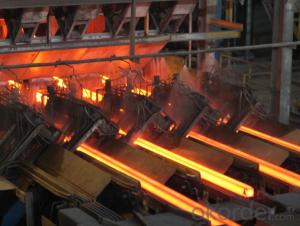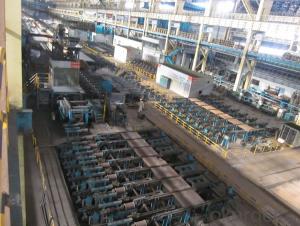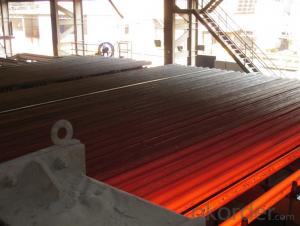Square Steel Billet Q235 Grade Prime Quality 2#
- Loading Port:
- Tianjin
- Payment Terms:
- TT OR LC
- Min Order Qty:
- 2000 m.t
- Supply Capability:
- 50000 m.t/month
OKorder Service Pledge
OKorder Financial Service
You Might Also Like
Description of Square Steel Billet Q235 Grade Prime Quality 2#
M. S. Billets are used for rolling of TMT Re-Bars of Fe415 and Fe500 Grade and various other structural steel products.
CRS Billets are used for rolling of CRS TMT Re-Bars.
Special Alloy Billets are used for rolling of any special grade TMT Re-Bars like Earthquake resistant TMT Re-Bars and for special grade structural steel products.
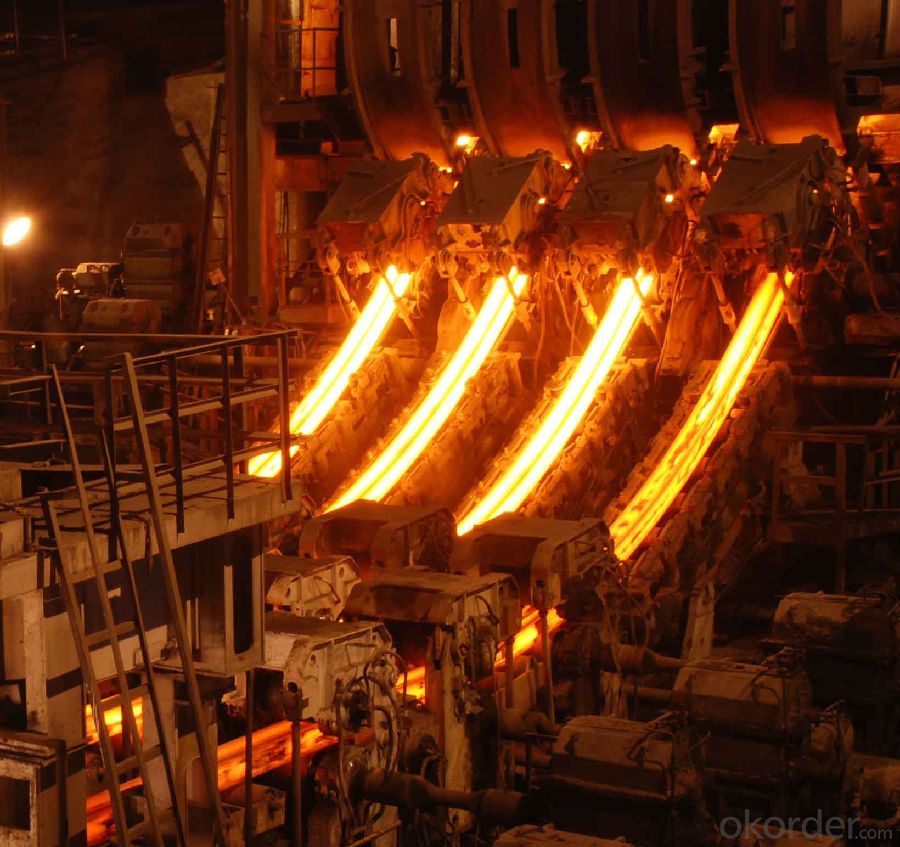
Main Feature Square Steel Billet Q235 Grade Prime Quality 2#
Raw elements(C,Fe,Ni,Mn,Cr,Cu.)---Smelted ingots by AOD finery---hot rolled into black suface---pickling in acid liquid---cold drawn----polished by automatically machine--- cutting into pieces---checking quanlity
Applications of Square Steel Billet Q235 Grade Prime Quality 2#
Widely Used in the areas such as Stainless Steel Fasteners, Chains, Kitchen and Sanitary wares, Furniture handles, Handrails, Electroplating and Electrolyzing pendants, Foods, Electron, Petroleum, Construction and Decoration, etc. Products have a high strength after cold-working. Electronic products parts, Medical appliance, Springs, Bus Inside and Outside packaging and building, Street Lamp Posts, etc. Decoration materials and Outdoor Publicity Billboard. Used for the products which have the Anti-Stress Corrosion requirement. Electron Products, Table-wares, Bolts, Nuts, Screen Meshes, Cumbustors and so on.
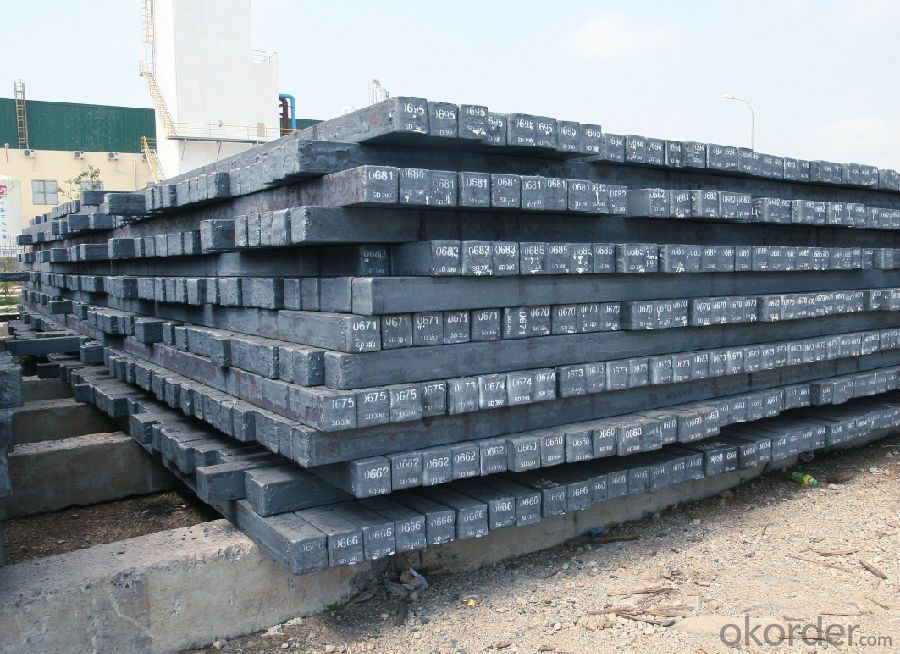
Specifications of Square Steel Billet Q235 Grade Prime Quality 2#
| Standard | C(%) | Mn(%) | S(%) | P(%) | Si(%) |
| Q195 | ≤0.12 | ≤0.50 | ≤0.040 | ≤0.035 | ≤0.30 |
| Q235 | ≤0.20 | ≤1.40 | ≤0.045 | ≤0.045 | ≤0.35 |
| Q275 | ≤0.22 | ≤1.50 | ≤0.045 | ≤0.045 | ≤0.35 |
| 20MnSi | 0.17-0.25 | 1.2-1.6 | ≤ 0.050 | ≤ 0.050 | 0.40-0.80 |
| 3SP | 0.14-0.22 | 0.40-0.85 | ≤ 0.050 | ≤ 0.040 | 0.05-0.15 |
| 5SP | 0.28-0.37 | 0.50-1.00 | ≤ 0.050 | ≤ 0.040 | 0.15-0.30 |
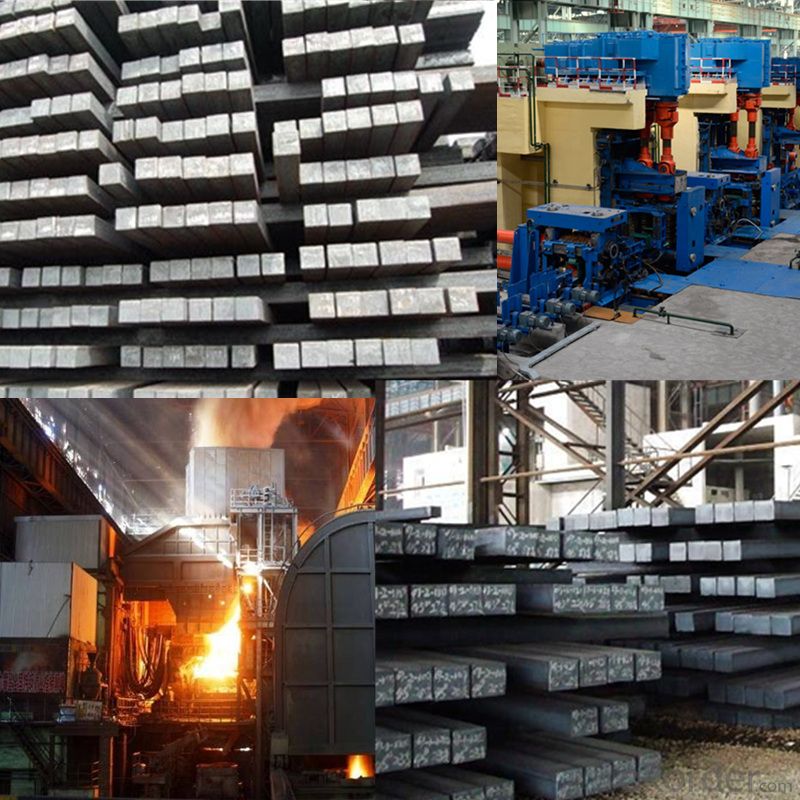
FAQ of Square Steel Billet Q235 Grade Prime Quality 2#
We have organized several common questions for our clients,may help you sincerely:
1. How Can I Visit There?
Our company is located in Tianjin City, China, near Beijing. You can fly to Tianjin Airport Directly. All our clients, from home or aboard, are warmly welcome to visit us!
2. How Can I Get Some Sample?
We are honored to offer you sample.
3. Why choose CNBM?
Our delivery time about 15-20days for standard sizes, if you have other requirements like hardness, quanity and width ,it is about 20-40days. But don't worry we also try our best for the delivery time ,because time longer and our cost is higher.
- Q:What are the different quality standards for steel billets?
- There are several quality standards for steel billets, including ASTM (American Society for Testing and Materials), ISO (International Organization for Standardization), and EN (European Norm) standards. These standards define various parameters such as chemical composition, mechanical properties, and dimensional tolerances that steel billets must meet in order to ensure their quality and suitability for different applications.
- Q:How are steel billets used in the manufacturing of oil and gas components?
- Steel billets are used in the manufacturing of oil and gas components as they serve as the raw material for various parts such as pipes, valves, flanges, and fittings. These billets are heated and then shaped through processes like extrusion, forging, or rolling to create the desired component. The strength, durability, and resistance to corrosion of steel make it an ideal material for oil and gas applications, ensuring the reliability and safety of the components used in the industry.
- Q:Can steel billets be used in the production of railway tracks?
- Yes, steel billets can be used in the production of railway tracks. Steel billets are commonly used as raw material for manufacturing various steel products, including railway tracks. The billets are first heated and then rolled into shape to create the required profile for the tracks. This process ensures the tracks have the necessary strength, durability, and dimensional accuracy to withstand the heavy loads and constant usage in railway operations.
- Q:What are the different methods of steel billet cutting and machining?
- Steel billets can be cut and machined using several different methods, each with its own advantages and applications. Some of the most commonly used methods include: 1. Sawing: To cut through a steel billet, a saw blade is employed. This method is relatively straightforward and cost-effective, making it suitable for cutting large quantities of billets into desired lengths. However, it may result in rough edges and necessitate additional finishing processes. 2. Flame cutting: Also known as oxy-fuel cutting, this method involves using a combination of fuel gas and oxygen to create a high-temperature flame that melts and cuts through the steel billet. It is effective for cutting thick billets and can achieve a high level of precision. Flame cutting can be carried out manually or using automated machines. 3. Plasma cutting: This method utilizes a plasma torch to generate a high-velocity jet of ionized gas that melts and cuts through the steel billet. It is particularly effective for cutting through thick materials and intricate shapes and curves. Plasma cutting provides high cutting speeds and excellent precision. 4. Waterjet cutting: In this method, a high-pressure jet of water mixed with abrasive particles is used to cut through the steel billet. Waterjet cutting is versatile and can handle various materials, including steel, without generating heat-affected zones or causing distortion. It is ideal for cutting complex shapes and thin materials. 5. Laser cutting: Laser cutting involves the use of a high-powered laser beam to melt and vaporize the steel billet along a predefined path. This method offers exceptional precision and enables intricate and complex cuts. Laser cutting is commonly used for thin to medium thickness billets and is suitable for both small-scale and industrial applications. In addition to these cutting methods, there are various machining processes that can be applied to steel billets, such as milling, turning, drilling, and grinding. These processes involve removing material from the billet to achieve desired shapes, dimensions, and surface finishes. The choice of machining method depends on factors such as the complexity of the part, required tolerances, and production volume. Overall, the different methods of steel billet cutting and machining provide a range of options for manufacturers to effectively shape and process steel billets according to their specific requirements.
- Q:What are the potential applications of steel billets in the automotive aftermarket?
- Steel billets have a wide range of potential applications in the automotive aftermarket. These applications can be primarily attributed to the strength, durability, and versatility of steel as a material. Firstly, steel billets can be used in the production of various automotive parts, such as engine components, transmission parts, suspension systems, and chassis components. Due to its high tensile strength and resistance to wear and tear, steel billets can provide the necessary structural integrity and longevity required in these critical automotive components. Additionally, steel billets can be used in the manufacturing of customized or aftermarket modifications for vehicles. These modifications can include performance upgrades, such as engine tuning, exhaust systems, and suspension modifications. Steel billets can be machined and formed into the desired shapes and sizes, allowing for precise customization and improved performance. Furthermore, steel billets can be utilized in the production of automotive tools and equipment used in the aftermarket. These tools can include jacks, stands, wrenches, and other specialized equipment required for repairs, maintenance, and modifications. The use of steel billets ensures that these tools are strong, durable, and capable of withstanding the demanding conditions of the automotive industry. Moreover, steel billets can be employed in the manufacturing of aftermarket body parts and accessories. These can range from exterior components such as bumpers, grilles, and fenders, to interior accessories like shift knobs, pedals, and trim pieces. Steel billets can be shaped, welded, and finished to meet the desired specifications and aesthetics of the vehicle owner, providing a wide range of options for customization. Overall, the potential applications of steel billets in the automotive aftermarket are vast and diverse. From critical engine components to performance upgrades, tools, and body modifications, steel billets offer the necessary strength, durability, and versatility required in the automotive industry.
- Q:Can steel billets be coated for improved corrosion resistance?
- Steel billets can be coated in various ways to enhance their resistance to corrosion. Coating them with a protective layer acts as a barrier between the steel and its environment, effectively preventing corrosion. There are several methods available for coating steel billets, including hot-dip galvanizing, electroplating, and powder coating. Hot-dip galvanizing involves immersing the steel billets in molten zinc, resulting in a thick and durable coating. This zinc coating not only provides excellent corrosion protection, even in harsh conditions, but also sacrificially corrodes before the steel, further enhancing its resistance to corrosion. Electroplating is another commonly used method for coating steel billets. Through an electrochemical reaction, a thin layer of a different metal, such as zinc, nickel, or chromium, is deposited onto the surface of the billets. This electroplated layer acts as a barrier against corrosion and can also add aesthetic appeal. Powder coating is a technique where a dry powder is applied to the surface of the steel billets and then heated to create a protective coating. This method not only offers excellent corrosion resistance but also provides additional benefits, including improved impact resistance and flexibility. By applying suitable coatings to steel billets, their corrosion resistance can be significantly enhanced, resulting in a longer lifespan and reduced maintenance needs. However, when choosing a coating method, factors such as the intended application, environmental conditions, and cost-effectiveness should be taken into consideration.
- Q:What is the average production cost of steel billets?
- The average cost of producing steel billets can differ depending on various factors such as location, production scale, raw material expenses, energy expenditures, labor charges, and other operational outlays. Nevertheless, typically, the average production cost of steel billets falls within the range of $400 to $600 per metric ton. It is crucial to acknowledge that the production cost can vary due to market conditions and the state of the global steel industry. Moreover, factors like technological advancements, efficiency measures, and economies of scale can also impact the production cost of steel billets. For those seeking precise and up-to-date information regarding the average production cost of steel billets, it is recommended to refer to industry reports, market analysts, or relevant trade associations. These sources can offer more specific and comprehensive data tailored to a particular region or market segment.
- Q:How are steel billets used in the production of valves?
- Steel billets are an integral component in the production of valves as they serve as the raw material for manufacturing valve bodies. Valve bodies are the main structural component of valves, providing the necessary strength and durability to withstand the high pressures and temperatures they are subjected to in various applications. To produce valve bodies, steel billets undergo several manufacturing processes. Initially, the billets are heated and then passed through a series of rollers to shape them into the desired form, typically a cylindrical or rectangular shape. This process, known as hot rolling, enhances the mechanical properties of the steel, making it more suitable for valve applications. After the hot rolling process, the steel billets are further processed through forging or machining operations to refine their shape and dimensions. Forging involves applying compressive forces to the heated billets, reshaping them into the final valve body form. On the other hand, machining involves removing excess material through cutting, drilling, and shaping to achieve the desired dimensions and surface finish. Once the valve bodies are formed, further processes such as drilling, threading, and finishing are carried out to create the necessary openings, connections, and surface smoothness required for the valve's functionality. These processes may involve using specialized machinery and tools to ensure precise and accurate dimensions. Overall, steel billets are crucial in the production of valves as they serve as the starting point for creating the valve bodies. The properties of steel, combined with the various manufacturing processes, enable the production of high-quality valves that can effectively control the flow of fluids or gases in various industrial applications.
- Q:How are steel billets used in the manufacturing of construction scaffolding?
- The manufacturing of construction scaffolding relies heavily on steel billets, which are an indispensable raw material. Initially, the billets are heated and then passed through rolling mills to achieve the desired shape and size for scaffolding components. Once the steel billets have been rolled to the required shape, they undergo further processing to create different scaffolding parts such as tubes, couplers, frames, and planks. These parts are then assembled together to form the scaffolding structure, which provides a secure and stable platform for workers during construction projects at elevated heights. There are several advantages to using steel billets in the manufacturing of construction scaffolding. Firstly, steel is renowned for its exceptional strength and durability, making it an ideal material for scaffolding. Additionally, it is resistant to corrosion and capable of withstanding harsh weather conditions, ensuring the scaffolding remains reliable and safe throughout the construction process. Furthermore, steel scaffolding is highly versatile and can be easily customized to meet various project requirements. By using steel billets, manufacturers can create scaffolding components of different sizes, shapes, and configurations to accommodate diverse construction needs. In conclusion, steel billets play a crucial role in the manufacturing of construction scaffolding. By utilizing these raw materials, scaffolding manufacturers can produce scaffolding structures that are durable, reliable, and customizable, ultimately enhancing safety and efficiency on construction sites.
- Q:What are the main disadvantages of using steel billets?
- There are several disadvantages associated with using steel billets in various industries. Firstly, one of the main drawbacks of steel billets is their high cost. Steel billets require a complex manufacturing process, involving melting and casting steel, which can be expensive. This cost is then transferred to the end product, making it less affordable for consumers. Secondly, steel billets tend to be heavy and bulky, making transportation and handling difficult. The weight and size of steel billets add to the overall logistical challenges in the supply chain, increasing costs and potentially causing delays. Another disadvantage is the limited availability of steel billets. Steel production requires a significant amount of resources and energy, and the availability of raw materials can be limited, leading to potential supply chain disruptions. This scarcity can negatively impact industries that rely heavily on steel billets for their operations. Furthermore, steel billets have limited shape flexibility. They are typically produced in standardized sizes and shapes, making it difficult to customize them for specific design requirements. This lack of flexibility can be a significant disadvantage in industries that require intricate and unique shapes for their products. Moreover, steel billets are prone to corrosion if not properly treated. The exposure to moisture and certain environments can cause rust and degradation, reducing the lifespan and durability of products made from steel billets. Regular maintenance and anti-corrosion treatments are essential to mitigate this disadvantage. Lastly, the production of steel billets has a significant environmental impact. The manufacturing process emits greenhouse gases and consumes large amounts of energy and water. These environmental concerns have led to increased scrutiny and regulations on steel production, adding additional costs and complexities to using steel billets. In conclusion, while steel billets have their advantages in terms of strength and durability, they also come with several drawbacks. These include high costs, transportation challenges, limited availability, lack of shape flexibility, susceptibility to corrosion, and environmental impact. It is crucial for industries to carefully consider these disadvantages when evaluating the use of steel billets in their operations.
1. Manufacturer Overview |
|
|---|---|
| Location | |
| Year Established | |
| Annual Output Value | |
| Main Markets | |
| Company Certifications | |
2. Manufacturer Certificates |
|
|---|---|
| a) Certification Name | |
| Range | |
| Reference | |
| Validity Period | |
3. Manufacturer Capability |
|
|---|---|
| a)Trade Capacity | |
| Nearest Port | |
| Export Percentage | |
| No.of Employees in Trade Department | |
| Language Spoken: | |
| b)Factory Information | |
| Factory Size: | |
| No. of Production Lines | |
| Contract Manufacturing | |
| Product Price Range | |
Send your message to us
Square Steel Billet Q235 Grade Prime Quality 2#
- Loading Port:
- Tianjin
- Payment Terms:
- TT OR LC
- Min Order Qty:
- 2000 m.t
- Supply Capability:
- 50000 m.t/month
OKorder Service Pledge
OKorder Financial Service
Similar products
New products
Hot products
Related keywords
